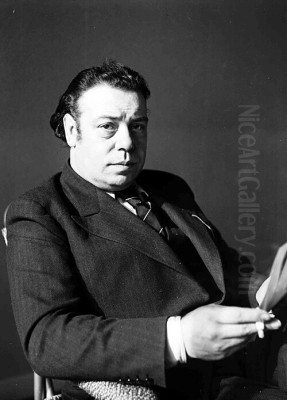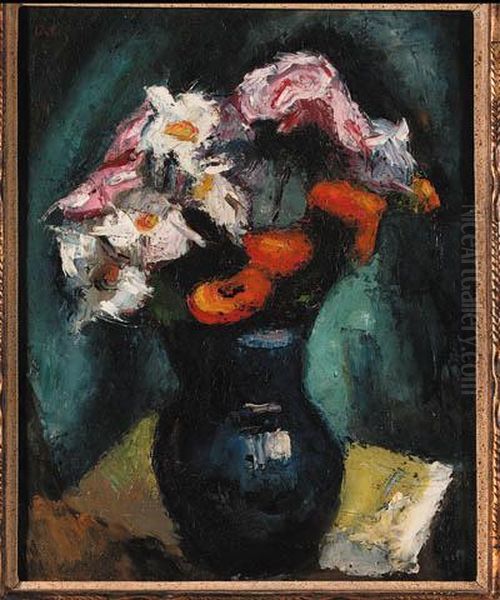
Manuel Ortiz de Zárate stands as a fascinating figure in the annals of early 20th-century art. A painter of Chilean nationality, though born on European soil, he became deeply embedded in the vibrant, revolutionary art scene of Montparnasse, Paris. While perhaps less globally renowned than some of his closest associates, Ortiz de Zárate was a talented artist in his own right and, crucially, a vital node in the network of modernists, forging significant friendships with giants like Pablo Picasso and Amedeo Modigliani. His life and work form a bridge between the artistic fervor of Europe and the burgeoning modern art movement in his adopted homeland of Chile.
European Birth, Chilean Roots
Manuel Ortiz de Zárate Montt was born not in Chile, but in Como, Italy, on October 9, 1886. His father was the noted Chilean composer Eleodoro Ortiz de Zárate. Despite his Italian birth, his family's strong Chilean identity shaped his nationality. He spent his early years in Chile, where his initial artistic inclinations likely began to form. However, the magnetic pull of Europe, the epicenter of artistic innovation at the turn of the century, proved irresistible for the aspiring painter.
Driven by a desire to immerse himself in the classical and contemporary currents of art, Ortiz de Zárate embarked on a journey back to Europe. His path initially led him through Italy, where he absorbed the lessons of the Renaissance masters, particularly in Florence. This period was formative, not just for his technical development but also for the connections he began to make within the international artistic community. His travels also took him to Brussels before he ultimately settled in Paris, the undisputed capital of the avant-garde.
Arrival in Montparnasse: The Crucible of Modernism

Paris in the early 1900s, specifically the Montparnasse district, was a melting pot of creativity, attracting artists, writers, and intellectuals from across the globe. Cafés like Le Dôme and La Rotonde buzzed with discussions of Fauvism, Cubism, and other emerging styles. Cheap studios, like those in the famous La Ruche complex, provided sanctuary for impoverished artists dreaming of changing the course of art history. It was into this dynamic, bohemian environment that Manuel Ortiz de Zárate arrived around 1906.
He quickly integrated into the expatriate and French artistic circles. Montparnasse offered a unique blend of camaraderie and intense artistic rivalry. Ortiz de Zárate, with his Latin American background and European sensibilities, found fertile ground here. He was not merely an observer but an active participant, contributing to the energy of the place through his work and his engaging personality. His presence added another thread to the rich tapestry of international artists converging on the Parisian scene.
Forging Key Friendships: Picasso and Modigliani
Among the most significant aspects of Ortiz de Zárate's time in Paris were his deep and enduring friendships with Pablo Picasso and Amedeo Modigliani. He became part of Picasso's inner circle, a group that frequented studios like the Bateau-Lavoir and debated the radical new directions art was taking. The source material notes that Ortiz de Zárate, through Picasso's recommendation, played a role in encouraging the Mexican painter Diego Rivera to come to Paris, highlighting his position as a trusted connector within the avant-garde network.
His relationship with Modigliani was equally profound. One well-documented anecdote recounts how, during his time in Florence before settling permanently in Paris, Ortiz de Zárate met Modigliani. He apparently painted such a vivid and enticing picture of the Parisian avant-garde scene that it significantly fueled Modigliani's desire to move there, despite his mother's reservations. This interaction underscores Ortiz de Zárate's role not just as a painter but as an enthusiastic ambassador for the modernist cause.
These friendships were not merely social; they involved shared artistic exploration and mutual support. The artists learned from each other, critiqued each other's work, and navigated the often-precarious existence of avant-garde painters together. Their interactions provide a window into the collaborative, albeit sometimes tumultuous, spirit of Montparnasse.
Navigating the Montparnasse Milieu
Ortiz de Zárate's connections extended far beyond Picasso and Modigliani. He was a familiar face in the studios and cafés frequented by the leading lights of modern art. The provided snippets mention his association with Henri Matisse, another titan of 20th-century art. While the source text's specific claims about funeral attendances are chronologically problematic (Matisse and Picasso outlived Ortiz de Zárate), the underlying point of his interaction with these figures is valid. A documented event places Ortiz de Zárate alongside Matisse and Picasso at the Lyre et Palette gallery in Montparnasse in 1916, an exhibition space known for showcasing modern art, also featuring artists like Moïse Kisling.
His circle included figures central to the development and promotion of Cubism and other movements. He knew Georges Braque, Picasso's co-founder of Cubism. He associated with painters like André Derain, a key figure in Fauvism, and Chaim Soutine, a close friend of Modigliani known for his expressive, turbulent style. The network also encompassed sculptors like Constantin Brâncuși, whose radical simplification of form revolutionized sculpture, and influential writers and critics like Guillaume Apollinaire and André Salmon, who championed the new art.
An illustrative story involves the artist Marie Vassilieff's canteen, a popular gathering spot. One evening, Vassilieff reportedly ejected a drunk and disruptive Modigliani. In a show of solidarity, Ortiz de Zárate and Picasso supposedly locked the door to protect their friend, a testament to the sometimes-dramatic camaraderie within the group. These interactions paint a picture of Ortiz de Zárate as a well-connected and respected member of this legendary artistic community.
Artistic Style and Development
Manuel Ortiz de Zárate's own artistic output reflects his immersion in the Parisian avant-garde, yet retains a distinct character. His work shows clear influences from the major movements surrounding him, particularly Cubism and the enduring legacy of Post-Impressionism, notably Paul Cézanne, whose structural approach to composition deeply impacted the Cubists. However, he did not simply replicate these styles.
His approach often synthesized elements of Cubist fragmentation and geometric structuring with a more lyrical or decorative sensibility. His palette could be vibrant, showing an appreciation for Fauvist color, or more subdued and earthy, akin to early Cubist works by Picasso and Braque. He engaged with typical modernist subjects: still lifes, portraits, and nudes.
Several representative works are mentioned in the source material. Nu allongé (Reclining Nude) suggests his engagement with the classical tradition of the nude, reinterpreted through a modern lens. Toréador (Bullfighter) points perhaps to his Spanish cultural heritage (via his Chilean roots) and the thematic interests shared with Picasso. Still lifes like Panier de fleurs et pommes (Basket of Flowers and Apples) and other Nature morte compositions allowed him to explore form, structure, and color, key preoccupations for artists influenced by Cézanne and Cubism. Cavalier sur le chemin (Rider on the Path, 1928) indicates a potential interest in landscape or genre scenes later in his career. His style often featured strong outlines and a focus on volume, blending analytical observation with expressive handling.
Bridging Continents: The Chilean Connection
While deeply integrated into the Parisian art world, Ortiz de Zárate never lost his connection to Chile. He became a pivotal figure for Chilean art, acting as a conduit for modernist ideas flowing from Europe to Latin America. He is recognized as one of the key figures associated with the "Grupo Montparnasse," a collective of Chilean artists who, like him, had spent time studying and working in Paris and sought to introduce modern European aesthetics to their homeland upon their return or through their continued work abroad. His brother, Julio Ortiz de Zárate, was also part of this movement.
The source material highlights his role in co-founding a group that aimed to bring aspects of Cubism, particularly as practiced in Paris, to Chile. A significant event was the 1923 exhibition he helped organize in Santiago, which showcased Chilean avant-garde art, heavily influenced by Parisian trends. This exhibition was a landmark moment, challenging the more conservative, academic traditions that had dominated Chilean art and signaling the arrival of modernism.
Through his efforts and those of his contemporaries like Camilo Mori, modern art began to take root in Chile. Ortiz de Zárate's unique position—respected in Paris yet committed to his Chilean identity—allowed him to play a crucial role in this transnational exchange, enriching the art scenes on both continents.
Personal Life
Beyond his artistic and social engagements, details about Ortiz de Zárate's personal life include his marriage. He was married to Marvena Piechowska, a painter of Polish origin. This union further situated him within the international artistic community of Paris, where relationships often crossed national and cultural lines, reflecting the cosmopolitan nature of Montparnasse itself. Their shared life as artists likely involved mutual support and artistic dialogue.
Later Years and Legacy
Manuel Ortiz de Zárate continued to paint and exhibit throughout his life. He remained connected to the evolving art world, though the intense, revolutionary fervor of the pre-World War I Montparnasse era eventually gave way to new trends and different social dynamics. His later work continued to develop, reflecting his ongoing engagement with modernist principles.
He passed away on October 28, 1946. While sources sometimes vary, his death is generally recorded as occurring in Los Angeles, California, suggesting he may have spent his final years in the United States, perhaps due to the disruptions of World War II in Europe or other personal reasons.
Manuel Ortiz de Zárate's legacy is multifaceted. As a painter, he produced a body of work that reflects the key artistic currents of his time, executed with skill and a personal vision. His paintings, such as the nudes, still lifes, and portraits mentioned, are appreciated for their blend of modernist structure and expressive quality, and they command attention in the art market.
However, his perhaps more significant contribution lies in his role as a connector and a cultural bridge. His deep friendships with Picasso, Modigliani, and others placed him at the very heart of the Montparnasse legend. He was more than a bystander; he was an active participant, a confidant, and a facilitator. Furthermore, his dedication to bringing European modernism to Chile marks him as a foundational figure in the history of 20th-century Chilean art. He helped shape the dialogue between Latin American artists and the international avant-garde.
Conclusion: An Enduring Presence
Manuel Ortiz de Zárate may not possess the household name recognition of Picasso or Modigliani, but his importance within the ecosystem of early 20th-century modernism is undeniable. He was a talented Chilean painter who navigated the complex and exhilarating world of Montparnasse, leaving his mark both through his own art and through his vital connections with other artists. His life story illuminates the interconnectedness of the global art scene during this transformative period and highlights his specific role in linking the European avant-garde with the development of modern art in Chile. He remains an essential figure for understanding the full breadth and human dimension of the Parisian art world and its international reach.